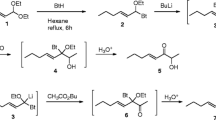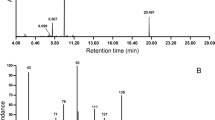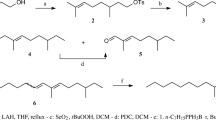Abstract
An attractant compound was isolated from frass produced byTrypodendron lineatum female beetles boring in Douglas fir. The proposed structure is one of two isomeric tricyclic acetals, to which the trivial name lineatin is assigned.
Similar content being viewed by others
References
Beroza, M. 1970. Determination of the chemical structure of organic compounds at the microgram level by gas chromatography.Acc. Chem. Res. 3:33–40.
Borden, J.H., andSlater, C.E. 1969. Sex pheromone ofTrypodendron lineatum: Production in the hindgut-Malpighian tubule region.Ann. Entomol. Soc. Am. 62:454–455.
Borden, J.H., Brownlee, R.G., andSilverstein, R.M. 1968. Sex pheromone ofTrypodendron lineatum (Coleoptera: Scolytidae): Production, bio-assay, and partial isolation.Can. Entomol. 100:629–636.
Borden, J.H.,Vandersar, T.J.D., andStokkink, E. 1975. Secondary attraction in the Scolytidae: An annotated bibliography.Simon Fraser Univ. Pest Mgt. Pap. No. 4.
Brownlee, R.G., andSilverstein, R.M. 1968. A micro-preparative gas chromatograph and a modified carbon skeleton determinator.Anal. Chem. 40:2077–2079.
Byrne, K.E., Swigar, A., Silverstein, R.M., Borden, J.H., andStokkink, E. 1974. Sulcatol: Population aggregation pheromone inGnathotrichus sulcatus (Coleoptera: Scolytidae).J. Insect Physiol. 20:1895–1900.
Chapman, J.A. 1966. The effect of attack by the ambrosia beetleTrypodendron lineatum (Olivier) on log attractiveness.Can. Entomol. 98:50–59.
Dyer, E.D.A., andKinghorn, J.M. 1961. Factors influencing the distribution of overwintering ambrosia beetles,Trypodendron lineatum (Oliv.)Can. Entomol. 93:746–759.
Fisher, R.A. 1954. Statistical Methods for Research Workers. Oliver and Boyd, Edinburgh.
Graham, K. 1968. Anaerobic induction of primary chemical attractancy for ambrosia beetles.Can. J. Zool. 46:905–908.
Moeck, H.A. 1970. Ethanol as the primary attractant for the ambrosia beetleTrypodendron lineatum (Coleoptera: Scolytidae).Can. Entomol. 102:985–995.
Nijholt, W.W. 1975. The striped ambrosia beetle,Trypodendron lineatum (Olivier): An annotated bibliography.Can. For. Serv. Pac. For. Res. Cent. Rep. BC-X-121.
Peacock, J.W., Silverstein, R.M., Lincoln, A.C., andSimeone, J.B. 1973. Laboratory investigations of the frass ofScolytus multistriatus (Coleoptera: Scolytidae) as a source of pheromone.Environ. Entomol. 2:355–359.
Pearce, G.T., Gore, W.E., Silverstein, R.M., Peacock, J.W., Cuthbert, R.A., Lanier, G.N., andSimeone, J.B. 1975. Chemical attractants for the smaller European elm bark beetleScolytus multistriatus (Coleoptera: Scolytidae).J. Chem. Ecol. 1:115–124.
Rondeau, R.E., andSievers, R.E. 1971. New superior paramagnetic shift reagents for NMR spectral clarification.J. Am. Chem. Soc. 93:1522–1524.
Rudinsky, J.A., andDaterman, G.E. 1964a. Response of the ambrosia beetleTrypodendron lineatum (Oliv.) to a female-produced pheromone.Z. Angew. Entomol. 54:300–303.
Rudinsky, J.A., andDaterman, G.E. 1964b. Field studies on flight patterns and olfactory responses of ambrosia beetles in Douglas-fir forests of western Oregon.Can. Entomol. 96:1339–1352.
Silverstein, R.M. 1970. Methodology for isolation and identification of insect pheromones: Examples from Coleoptera, pp 285–299,in D.L. Wood, R.M. Silverstein, and M. Nakajima (eds.). Control of Insect Behavior by Natural Products. Academic Press, New York.
Tumlinson, J.H., Gueldner, R.C., Hardee, D.D., Thompson, A.C., Hedin, P.A., andMinyard, J.P. 1971. Identification and synthesis of the four compounds comprising the boll weevil sex attractant.J. Org. Chem. 36:2616–2621.
Author information
Authors and Affiliations
Additional information
Research supported by: National Science Foundation (U.S.A.) Grant No. PCM 74-13643, National Research Council (Canada) Operating Grant No. A3881, Canada Department of Fisheries and Forestry Extramural Research Grant No. F-58, Canadian Forestry Service Science Subvention Grant, and the Council of Forest Industries of British Columbia.
Rights and permissions
About this article
Cite this article
Macconnell, J.G., Borden, J.H., Silverstein, R.M. et al. Isolation and tentative identification of lineatin, a pheromone from the frass ofTrypodendron lineatum (Coleoptera: Scolytidae). J Chem Ecol 3, 549–561 (1977). https://doi.org/10.1007/BF00989076
Received:
Revised:
Issue Date:
DOI: https://doi.org/10.1007/BF00989076




